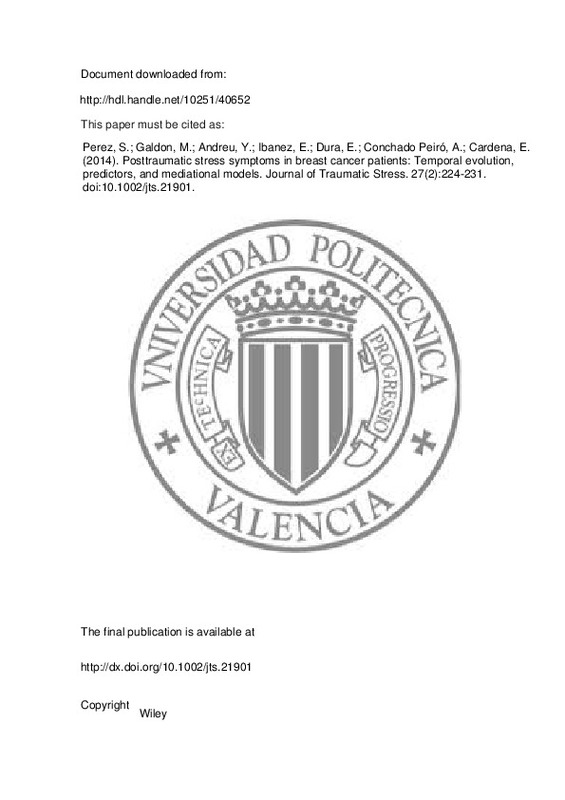American Psychiatric Association. (2013). Diagnostic and Statistical Manual of Mental Disorders. doi:10.1176/appi.books.9780890425596
Andreu, Y., Galdón, M. J., Durá, E., Martínez, P., Pérez, S., & Murgui, S. (2012). A longitudinal study of psychosocial distress in breast cancer: Prevalence and risk factors. Psychology & Health, 27(1), 72-87. doi:10.1080/08870446.2010.542814
Andreu , Y. Galdón , M. J. Murgui , S. Martínez , P. Pérez , S. Romero , R. 2013 Psychometric properties of the Spanish version of the Mini-Mental Adjustment to Cancer (Mini-MAC) Scale
[+]
American Psychiatric Association. (2013). Diagnostic and Statistical Manual of Mental Disorders. doi:10.1176/appi.books.9780890425596
Andreu, Y., Galdón, M. J., Durá, E., Martínez, P., Pérez, S., & Murgui, S. (2012). A longitudinal study of psychosocial distress in breast cancer: Prevalence and risk factors. Psychology & Health, 27(1), 72-87. doi:10.1080/08870446.2010.542814
Andreu , Y. Galdón , M. J. Murgui , S. Martínez , P. Pérez , S. Romero , R. 2013 Psychometric properties of the Spanish version of the Mini-Mental Adjustment to Cancer (Mini-MAC) Scale
Andrykowski, M. A., & Kangas, M. (2010). Posttraumatic Stress Disorder Associated with Cancer Diagnosis and Treatment. Psycho-Oncology, 348-357. doi:10.1093/med/9780195367430.003.0047
BERNSTEIN, E. M., & PUTNAM, F. W. (1986). Development, Reliability, and Validity of a Dissociation Scale. The Journal of Nervous and Mental Disease, 174(12), 727-735. doi:10.1097/00005053-198612000-00004
Bleiker, E. M. A., Pouwer, F., van der Ploeg, H. M., Leer, J.-W. H., & Adèr, H. J. (2000). Psychological distress two years after diagnosis of breast cancer: frequency and prediction. Patient Education and Counseling, 40(3), 209-217. doi:10.1016/s0738-3991(99)00085-3
Brennan, J. (2001). Adjustment to cancer?coping or personal transition? Psycho-Oncology, 10(1), 1-18. doi:10.1002/1099-1611(200101/02)10:1<1::aid-pon484>3.0.co;2-t
Brewin, C. R., Andrews, B., & Valentine, J. D. (2000). Meta-analysis of risk factors for posttraumatic stress disorder in trauma-exposed adults. Journal of Consulting and Clinical Psychology, 68(5), 748-766. doi:10.1037/0022-006x.68.5.748
Briere, J., Scott, C., & Weathers, F. (2005). Peritraumatic and Persistent Dissociation in the Presumed Etiology of PTSD. American Journal of Psychiatry, 162(12), 2295-2301. doi:10.1176/appi.ajp.162.12.2295
Cardeña, E., & Carlson, E. (2011). Acute Stress Disorder Revisited. Annual Review of Clinical Psychology, 7(1), 245-267. doi:10.1146/annurev-clinpsy-032210-104502
Cardeña, E., Koopman, C., Classen, C., Waelde, L. C., & Spiegel, D. (2000). Psychometric properties of the Stanford Acute Stress Reaction Questionnaire (SASRQ): A valid and reliable measure of acute stress. Journal of Traumatic Stress, 13(4), 719-734. doi:10.1023/a:1007822603186
Cardeña , E. Maldonado , J. 2001 Translation into Spanish of the SASRQ Unpublished manuscript
Carver, C. S., & Connor-Smith, J. (2010). Personality and Coping. Annual Review of Psychology, 61(1), 679-704. doi:10.1146/annurev.psych.093008.100352
Cohen, S., & Wills, T. A. (1985). Stress, social support, and the buffering hypothesis. Psychological Bulletin, 98(2), 310-357. doi:10.1037/0033-2909.98.2.310
Eckhardt , J. R. 1998 Coping style and symptoms of posttraumatic stress disorder among women with primary breast cancer. Unpublished doctoral dissertation, California School of Professional Psychology at Alameda
Foa, E. B., Steketee, G., & Rothbaum, B. O. (1989). Behavioral/cognitive conceptualizations of post-traumatic stress disorder. Behavior Therapy, 20(2), 155-176. doi:10.1016/s0005-7894(89)80067-x
Green, B. L., Krupnick, J. L., Rowland, J. H., Epstein, S. A., Stockton, P., Spertus, I., & Stern, N. (2000). Trauma History as a Predictor of Psychologic Symptoms in Women With Breast Cancer. Journal of Clinical Oncology, 18(5), 1084-1084. doi:10.1200/jco.2000.18.5.1084
Greer, S. (1991). Psychological response to cancer and survival. Psychological Medicine, 21(1), 43-49. doi:10.1017/s003329170001463x
GROSSARTH-MATICEK, R. (1990). PERSONALITY, STRESS AND DISEASE: DESCRIPTION ANDVALIDATION OF A NEW INVENTORY. Psychological Reports, 66(2), 355. doi:10.2466/pr0.66.2.355-373
Gurevich, M., Devins, G. M., & Rodin, G. M. (2002). Stress Response Syndromes and Cancer: Conceptual and Assessment Issues. Psychosomatics, 43(4), 259-281. doi:10.1176/appi.psy.43.4.259
Ho, S. M. Y., Chan, C. L. W., & Ho, R. T. H. (2004). Posttraumatic growth in chinese cancer survivors. Psycho-Oncology, 13(6), 377-389. doi:10.1002/pon.758
Kangas, M., Henry, J. L., & Bryant, R. A. (2005). Predictors of posttraumatic stress disorder following cancer. Health Psychology, 24(6), 579-585. doi:10.1037/0278-6133.24.6.579
Kangas, M., Henry, J. L., & Bryant, R. A. (2005). The Relationship Between Acute Stress Disorder and Posttraumatic Stress Disorder Following Cancer. Journal of Consulting and Clinical Psychology, 73(2), 360-364. doi:10.1037/0022-006x.73.2.360
Kangas, M., Henry, J. L., & Bryant, R. A. (2007). Correlates of acute stress disorder in cancer patients. Journal of Traumatic Stress, 20(3), 325-334. doi:10.1002/jts.20253
Lanius, R. A., Brand, B., Vermetten, E., Frewen, P. A., & Spiegel, D. (2012). THE DISSOCIATIVE SUBTYPE OF POSTTRAUMATIC STRESS DISORDER: RATIONALE, CLINICAL AND NEUROBIOLOGICAL EVIDENCE, AND IMPLICATIONS. Depression and Anxiety, 29(8), 701-708. doi:10.1002/da.21889
Mehnert, A., & Koch, U. (2007). Prevalence of acute and post-traumatic stress disorder and comorbid mental disorders in breast cancer patients during primary cancer care: a prospective study. Psycho-Oncology, 16(3), 181-188. doi:10.1002/pon.1057
Mehnert, A., & Koch, U. (2008). Psychological comorbidity and health-related quality of life and its association with awareness, utilization, and need for psychosocial support in a cancer register-based sample of long-term breast cancer survivors. Journal of Psychosomatic Research, 64(4), 383-391. doi:10.1016/j.jpsychores.2007.12.005
Mosher, C. E., & Danoff-Burg, S. (2006). A Review of Age Differences in Psychological Adjustment to Breast Cancer. Journal of Psychosocial Oncology, 23(2-3), 101-114. doi:10.1300/j077v23n02_07
Norris, F. H., & Kaniasty, K. (1996). Received and perceived social support in times of stress: A test of the social support deterioration deterrence model. Journal of Personality and Social Psychology, 71(3), 498-511. doi:10.1037/0022-3514.71.3.498
Rokach, A., Moya, M. C., Orzeck, T., & Exposito, F. (2001). LONELINESS IN NORTH AMERICA AND SPAIN. Social Behavior and Personality: an international journal, 29(5), 477-489. doi:10.2224/sbp.2001.29.5.477
Shek, D. T. L., & Ma, C. M. S. (2011). Longitudinal Data Analyses Using Linear Mixed Models in SPSS: Concepts, Procedures and Illustrations. The Scientific World JOURNAL, 11, 42-76. doi:10.1100/tsw.2011.2
Shelby, R. A., Golden-Kreutz, D. M., & Andersen, B. L. (2008). PTSD diagnoses, subsyndromal symptoms, and comorbidities contribute to impairments for breast cancer survivors. Journal of Traumatic Stress, 21(2), 165-172. doi:10.1002/jts.20316
Taylor, S. E., & Stanton, A. L. (2007). Coping Resources, Coping Processes, and Mental Health. Annual Review of Clinical Psychology, 3(1), 377-401. doi:10.1146/annurev.clinpsy.3.022806.091520
Tjemsland, L., Søreide, J. A., & Malt, U. F. (1998). Posttraumatic distress symptoms in operable breast cancer III: Breast Cancer Research and Treatment, 47(2), 141-151. doi:10.1023/a:1005957302990
Watson, M., Law, M. G., Santos, M. dos, Greer, S., Baruch, J., & Bliss, J. (1994). The Mini-MAC. Journal of Psychosocial Oncology, 12(3), 33-46. doi:10.1300/j077v12n03_03
[-]







![[Cerrado]](/themes/UPV/images/candado.png)


